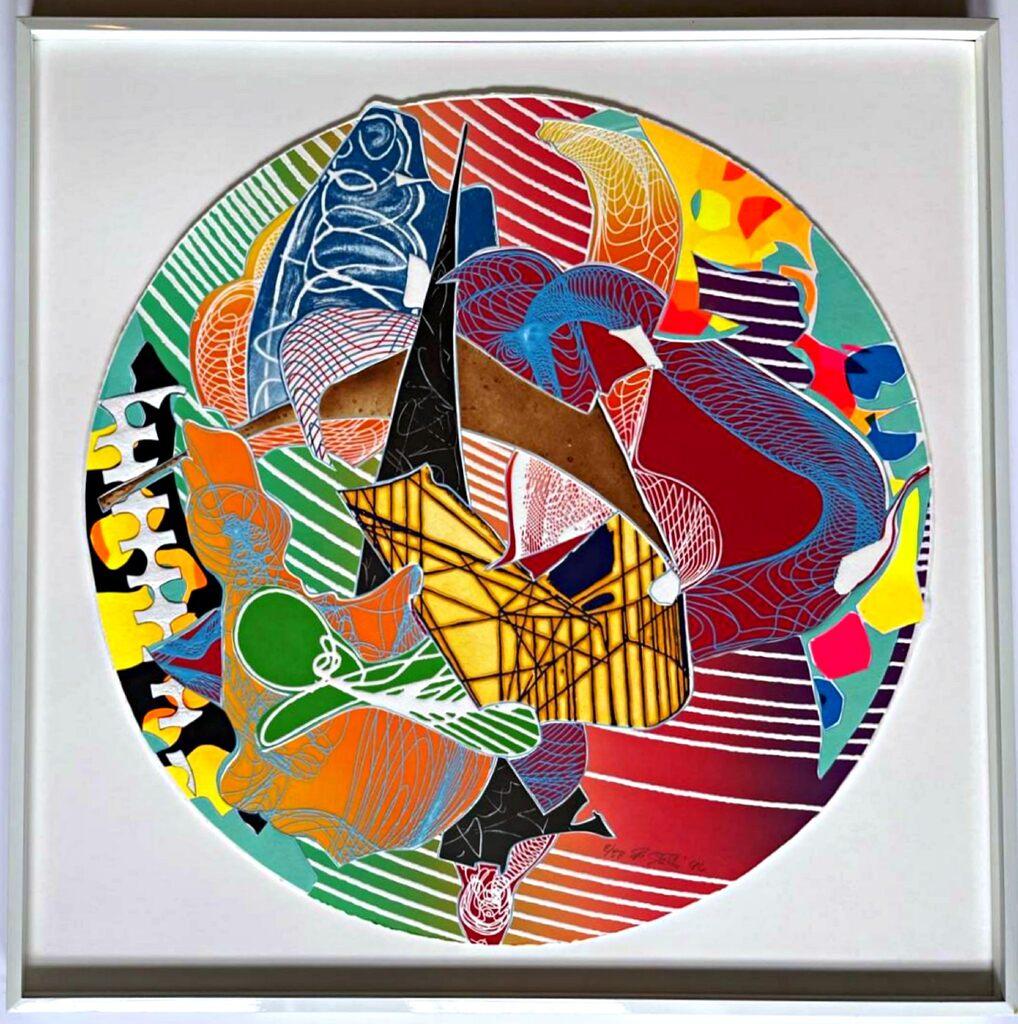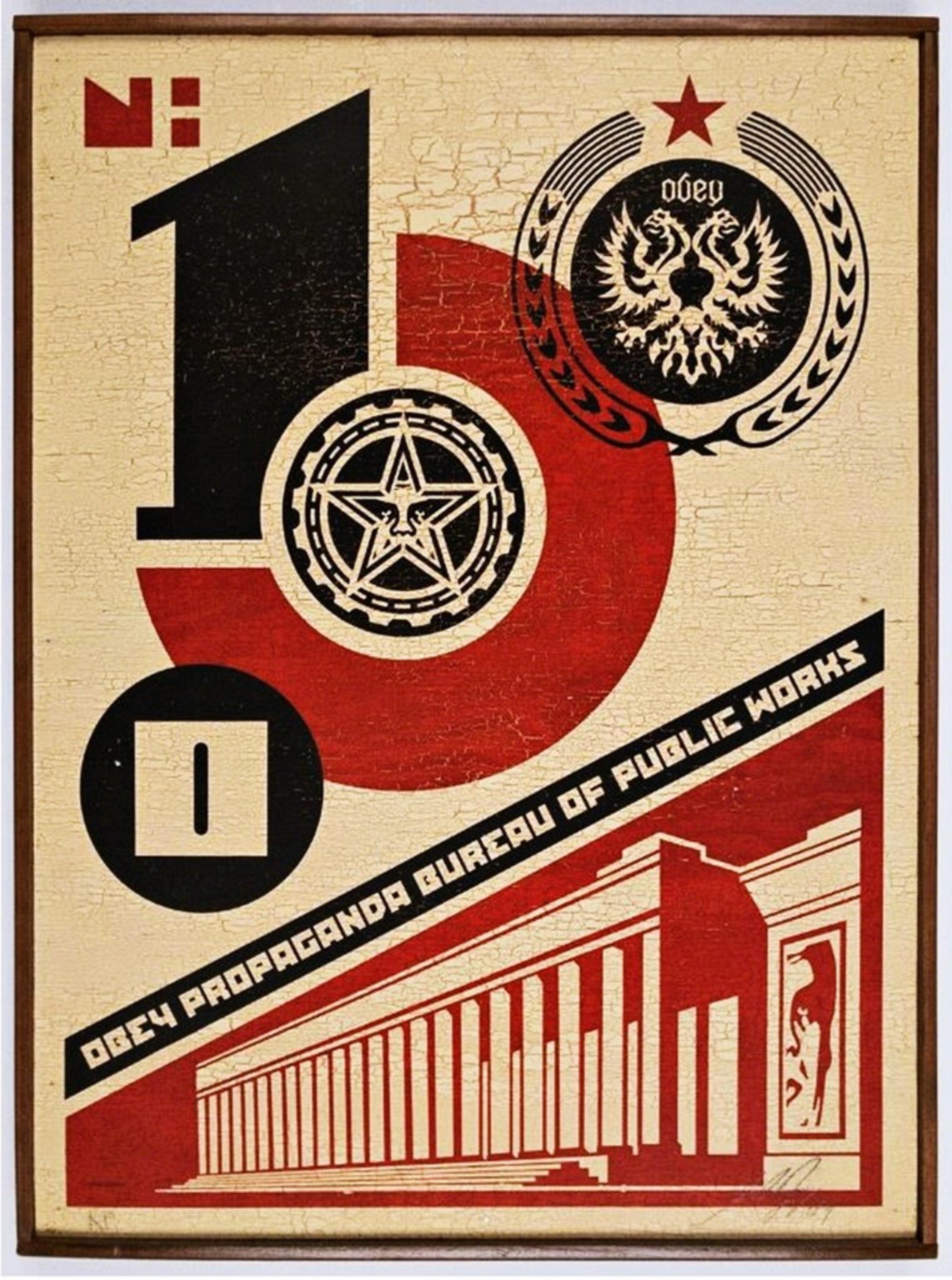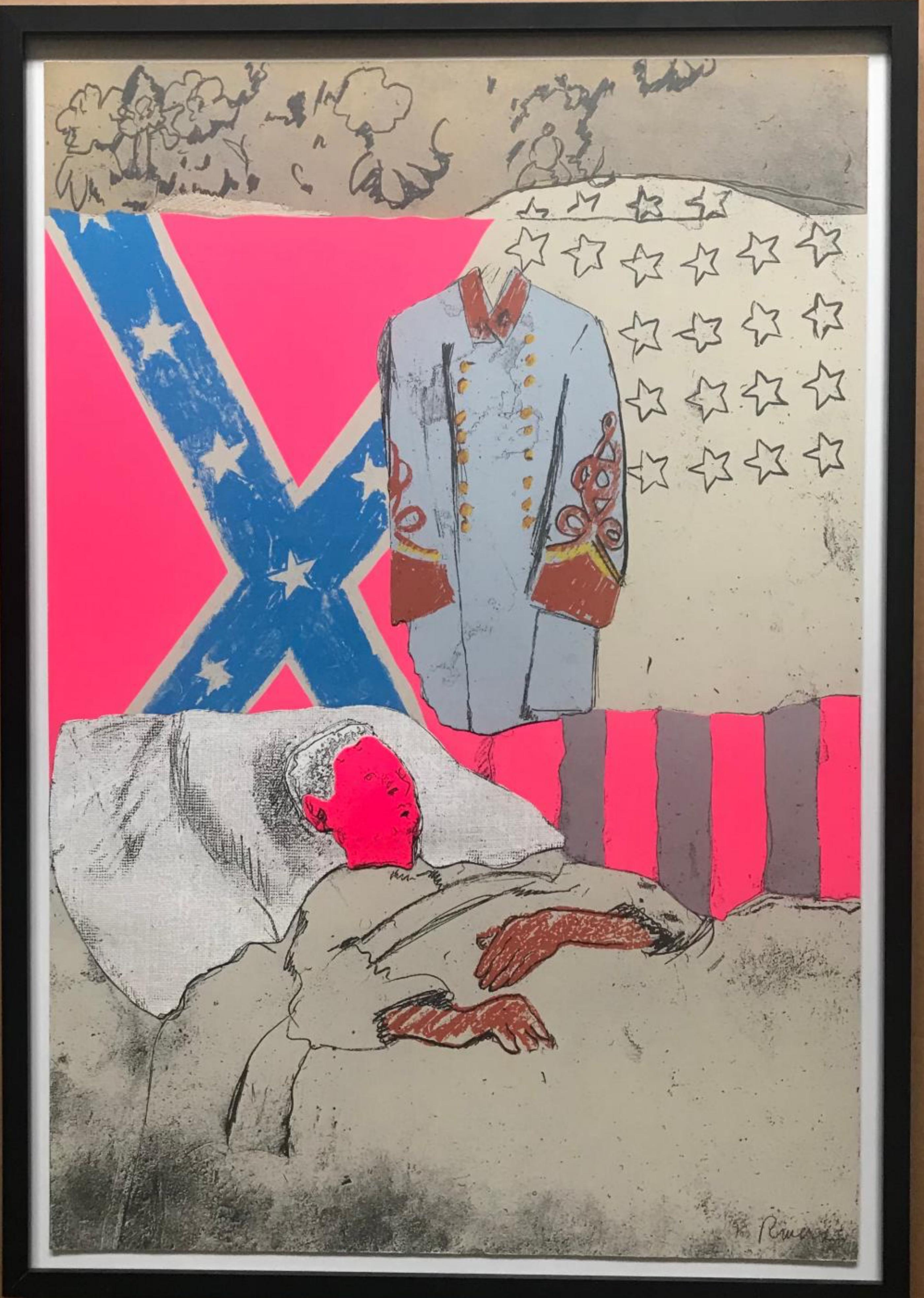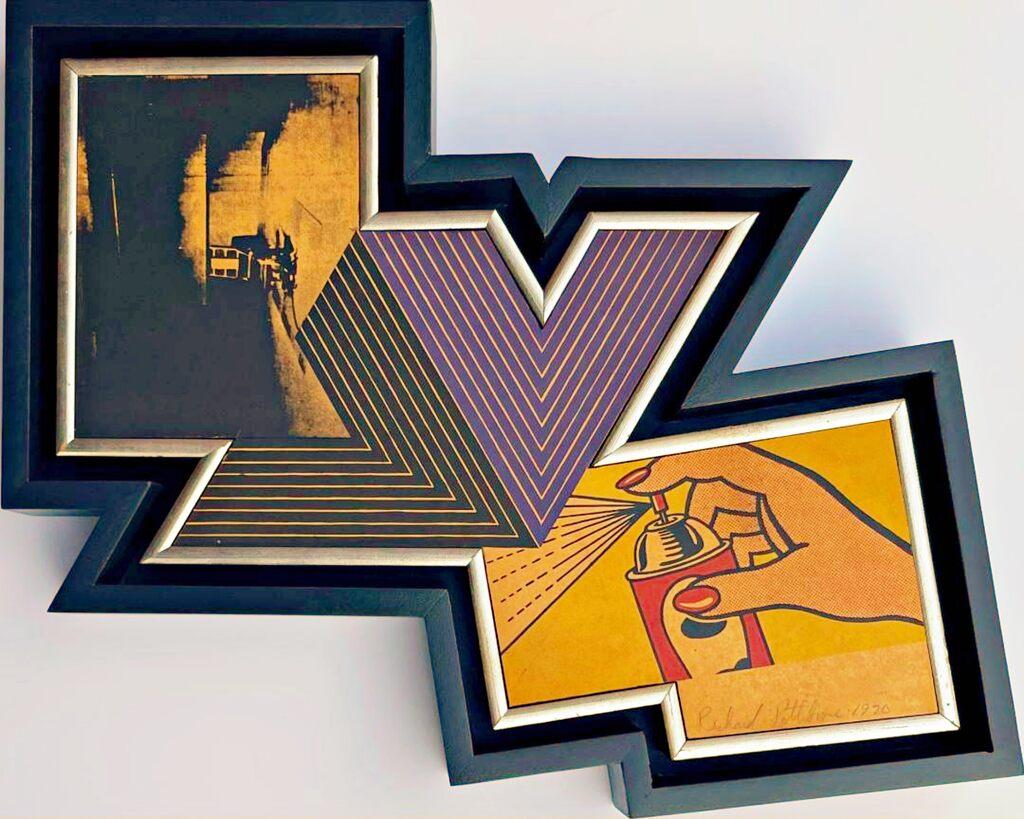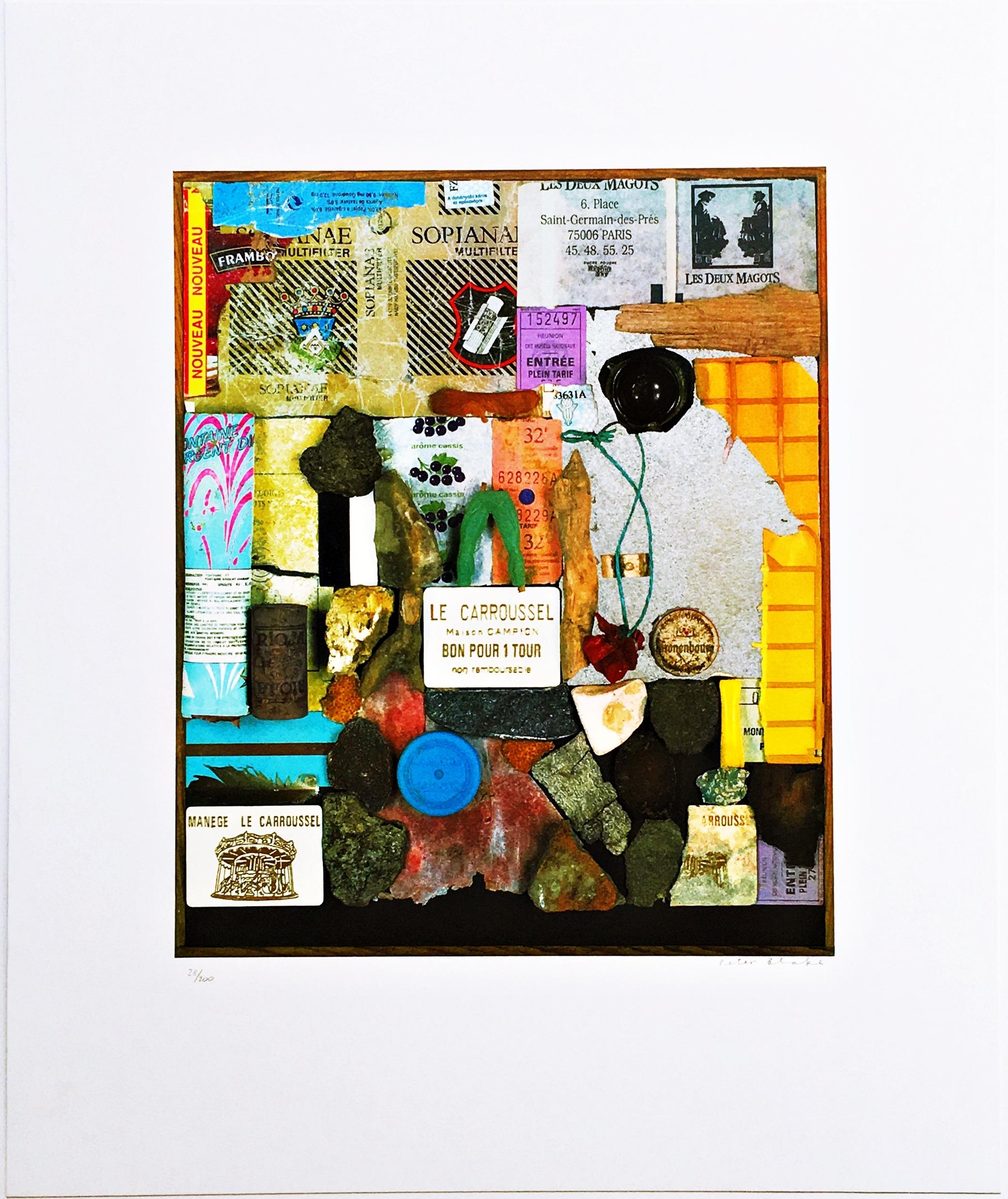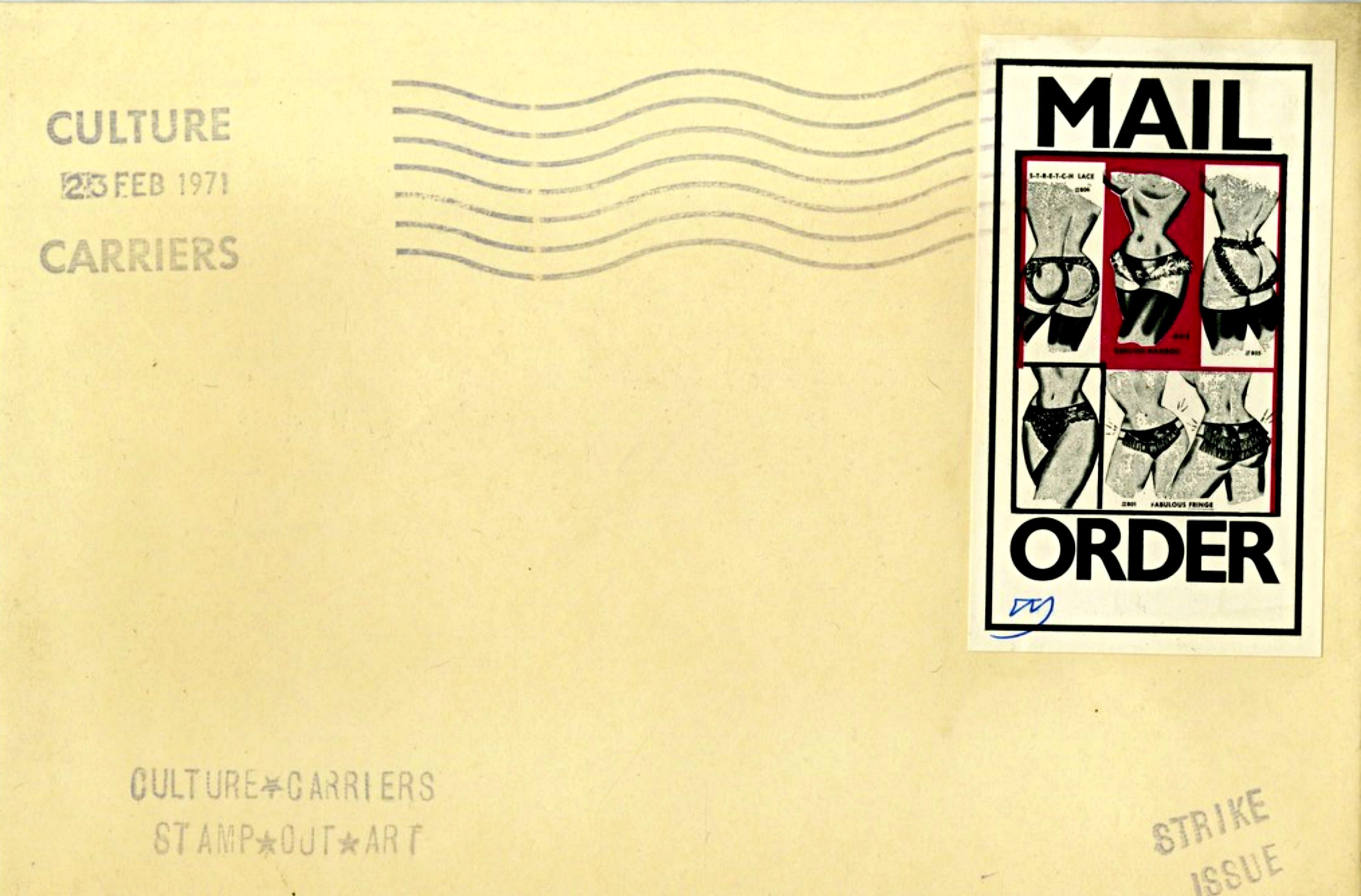Items Similar to Cockatoo AAA Dracula, Mixed media & lithograph, hand signed, 20/20, artist label
Want more images or videos?
Request additional images or videos from the seller
1 of 10
Billy Al BengstonCockatoo AAA Dracula, Mixed media & lithograph, hand signed, 20/20, artist label1968
1968
About the Item
Billy Al Bengston
Cockatoo AAA Dracula, 1968
Lithograph , Zinc and Aluminum, in Silver-Violet, Yellow, Two Grays and Orange on uncalendered Rives paper
Frame included
signed faintly on the front (visible in person) and numbered 20/20 back on the artist's studio label
Tamarind Lithography Workshop, Inc., Los Angeles
This late 1960s work is irregularly shaped by design. It is framed and bears the artist's studio label verso. This piece is rarely seen on the marketplace as other editions are in major museum collections including MOMA, The National Gallery of Art, LACMA and others.
Measurements:
Frame:
13.75 x 13 x 3 inches
Artwork:
11 3/4 × 11 × 1.5 inch
The work is signed on the front. Billy Al famously signed lightly. This print is irregularly shaped by design - it is deliberately slanted even when removed from the square frame.
- Creator:Billy Al Bengston (1934, American)
- Creation Year:1968
- Dimensions:Height: 13.75 in (34.93 cm)Width: 13 in (33.02 cm)Depth: 3 in (7.62 cm)
- Medium:
- Movement & Style:
- Period:
- Condition:Very good original studio condition. The print is irregularly shaped by design.
- Gallery Location:New York, NY
- Reference Number:1stDibs: LU1745214338632
Billy Al Bengston
Based in Venice, California, Billy Al Bengston burst onto the scene in the 1950s with his passion for motorcycle racing and art. Bengston was discharged from the California College of Arts and Crafts in 1955 for depleting the clay supply. Following this exit, he enrolled at the Otis Art Institute to study under Peter Voulkos whom he later named as a significant influence, along with Richard Diebenkorn. Bengston found immediate success in the Los Angeles art scene, enjoying multiple solo shows at Ferus Gallery and a 1968 exhibition at the Los Angeles County Museum of Art. His artistic output, mainly sculpture and painting, is informed by a variety of influences that range from his love of motorcycles and car-detailing techniques to recurring geometric shapes similar to those of Jasper Johns. Art historian Andrew Perchuck included Bengston among the "West Coast artists, including Robert Irwin and Ken Price, who were instrumental in redefining the terms of artistic identity in the early 60s by insisting that sub-cultural affinities and leisure-time activities (surfing, car customizing) were at the foundation of their artistic personas."
About the Seller
5.0
Platinum Seller
These expertly vetted sellers are 1stDibs' most experienced sellers and are rated highest by our customers.
Established in 2007
1stDibs seller since 2022
303 sales on 1stDibs
Typical response time: 1 hour
- ShippingRetrieving quote...Ships From: New York, NY
- Return PolicyA return for this item may be initiated within 1 day of delivery.
More From This SellerView All
- Plutusia, from Imaginary Places II (Axsom 246). hand signed/N, FramedBy Frank StellaLocated in New York, NYFrank Stella Plutusia, from Imaginary Places II (Axsom & Schnitzer, 246), 1996 52 color lithograph, screenprint, etching, aquatint, relief, mezzotint, engraving on white TGL handmade...Category
1990s Pop Art Abstract Prints
MaterialsFoil
- Hockney's Alphabet, portfolio of 26 lithographs signed by Hockney and 23 writersBy David HockneyLocated in New York, NYDavid Hockney Hockney's Alphabet, 1991 26 color lithographs in Fine Art Cartridge paper bound in quarter vellum with handmade Fabriano Roma paper sides, housed in matching box; signed by David Hockney and most contributors in ink and numbered 178 in black ink on the justification page Numbered 178/250 Hand signed by 24 of the contributors, including David Hockney and Steven Spender 12 5/8 x 9 5/8 inches Bound in book and held in slipcase This portfolio features 26 color lithographs in Fine Art Cartridge paper with full margins, bound as issued, in quarter vellum with handmade Fabriano Roma paper sides, in original grey slipcase. It is signed by David Hockney (the artist) and most contributors in ink and numbered 178 in black ink on the justification page, from the edition of 250, with full text and title page, published by Faber & Faber, London, text edits by Stephen Spender, who also signed. It is illustrated by David Hockney, hand signed by David Hockney and Stephen Spender and also signed by the following contributors: Douglas Adams, Martin Amis, Julian Barnes, William Boyd, Margaret Drabble, Patrick Leigh Fermor, William Golding, Seamus Heaney...Category
1990s Pop Art Abstract Prints
MaterialsInk, Mixed Media, Vellum, Lithograph, Board, Pencil, Offset
- The MCA Wrapped, 1969 (Limited Edition of 300) gold foil stamp museum provenanceBy ChristoLocated in New York, NYChristo The MCA (Museum of Contemporary Art) Wrapped, Chicago, 1969, 2019 Limited Edition Four-color offset lithograph on 110 lb. Crane Lettra Cover stock, with an elegant gold foil...Category
2010s Pop Art Figurative Prints
MaterialsFoil
- Bureau of Public Works (Mixed Media on Wood) Twice Signed Artists Proof Ed of 2By Shepard FaireyLocated in New York, NYSHEPARD FAIREY Bureau of Public Works (on Wood), 2004 Mixed media silkscreen on wood panel. Hand signed and annotated on both the recto and verso. In original handmade artist's frame...Category
Early 2000s Pop Art Mixed Media
MaterialsWood, Mixed Media, Screen, Pencil
- The Last Civil War Veteran limited edition signed mixed media silkscreen collageBy Larry RiversLocated in New York, NYLarry Rivers The Last Civil War Veteran, 1970 Silkscreen and mixed media collage on paper 29 × 19 3/4 inches Frame included Hand signed and numbered 55/100 in graphite pencil lower front 1970 Mixed media collage multiple based upon famous Larry Rivers 1961 painting "The Last Civil War Veteran'. (In 1979-80, Rivers reprised this theme with another edition of 125, but this is the original 1970 print from the limited edition of only 100) In 1962, the Museum of Modern Art acquired The Last Civil War Veteran and by early 1963 put it on view. 1963 marked the hundred-year anniversary of the Emancipation Proclamation...Category
1970s Pop Art Abstract Prints
MaterialsMixed Media, Screen, Laid Paper, Pencil, Graphite
- The Appropriation piece: Andy Warhol, Frank Stella, Roy Lichtenstein Unique var.By Richard PettiboneLocated in New York, NYRichard Pettibone The Appropriation Print Andy Warhol, Frank Stella, Roy Lichtenstein, 1970 Silkscreen in colors on masonite board (unique variant on sculpted board) Hand-signed by artist, Signed and dated on the front (see close up image) Bespoke frame Included This is a rare example of Pettibone's iconic Appropriation Print, as it's silkscreened and sculpted on masonite board rather than paper, giving it a different background hue, and enabling it work to be framed so uniquely. The Appropriation print is one of the most coveted prints Pettibone ever created ; the regular edition is on a full sheet with white background; the present example was silkscreened on board, allowing it to be framed in 3-D. While we do not know how many examples of this graphic work Pettibone created, so far the present work is the only one example we have ever seen on the public market since 1970. (Other editions of The Appropriation Print have been printed on vellum, wove paper and pink and yellow paper.) This 1970 homage to Andy Warhol, Frank Stella and Roy Lichtenstein exemplifies the type of artistic appropriation he was engaging in early on during the height of the Pop Art movement - long before more contemporary artists like Deborah Kass, Louise Lawler, etc. followed suit. This silkscreen was in its original 1970 vintage period frame; a bespoke custom hand cut black wood outer frame was subsequently created especially to house the work, giving it a distinctive sculptural aesthetic. Measurements: Framed 14.5 inches vertical by 18 inches horizontal by 2 inches Work 13 inches vertical by 16.5 inches horizontal Richard Pettibone biography: Richard Pettibone (American, b.1938) is one of the pioneering artists to use appropriation techniques. Pettibone was born in Los Angeles, and first worked with shadow boxes and assemblages, illustrating his interest in craft, construction, and working in miniature scales. In 1964, he created the first of his appropriated pieces, two tiny painted “replicas” of the iconic Campbell’s soup cans by Andy Warhol (American, 1928–1987). By 1965, he had created several “replicas” of paintings by American artists, such as Warhol, Roy Lichtenstein (1923–1997), Ed Ruscha (b.1937), and others, among them some of the biggest names in Pop Art. Pettibone chose to recreate the work of leading avant-garde artists whose careers were often centered on themes of replication themselves, further lending irony to his work. Pettibone also created both miniature and life-sized sculptural works, including an exact copy of Bicycle Wheel by Marcel Duchamp (French, 1887–1968), and in the 1980s, an entire series of sculptures of varying sizes replicating the most famous works of Constantin Brancusi (Romanian, 1876–1957). In more recent years, Pettibone has created paintings based on the covers of poetry books by Ezra Pound, as well as sculptures drawn from the grid compositions of Piet Mondrian (Dutch, 1872–1944). Pettibone straddles the lines of appropriation, Pop, and Conceptual Art, and has received critical attention for decades for the important questions his work raises about authorship, craftsmanship, and the original in art. His work has been exhibited at the Institute for Contemporary Art in Philadelphia, the Museum of Modern Art in New York, the Museum of Contemporary Art in Miami, and the Laguna Art Museum in Laguna Beach, CA. Pettibone is currently based in New York. "I wished I had stuck with the idea of just painting the same painting like the soup can and never painting another painting. When someone wanted one, you would just do another one. Does anybody do that now?" Andy Warhol, 1981 Since the mid-1960s, Richard Pettibone has been making hand-painted, small-scale copies of works by other artists — a practice due to which he is best known as a precursor of appropriation art — and for a decade now, he has been revisiting subjects from across his career. In his latest exhibitions at Castelli Gallery, Pettibone has been showing more of the “same” paintings that had already been part of his 2005–6 museum retrospective,1 and also including “new” subject matter drawn from his usual roster of European modernists and American postwar artists. Art critic Kim Levin laid out some phases of the intricate spectrum from copies to repetitions in her review of the Warhol-de Chirico showdown, a joint exhibition at the heyday of appropriation art in the mid-1980s when Warhol’s appropriations of de Chirico’s work effectively revaluated “the grand old auto-appropriator”. Upon having counted well over a dozen Disquieting Muses by de Chirico, Levin speculated: “Maybe he kept doing them because no one got the point. Maybe he needed the money. Maybe he meant it when he said his technique had improved, and traditional skills were what mattered.” On the other side, Warhol, in her eyes, was the “latter-day exemplar of museless creativity”. To Pettibone, traditional skills certainly still matter, as he practices his contemporary version of museless creativity. He paints the same painting again and again, no matter whether anybody shows an interest in it or not. His work, of course, takes place well outside the historical framework of what Levin aptly referred to as the “modern/postmodern wrestling match”, but neither was this exactly his match to begin with. Pettibone is one of appropriation art’s trailblazers, but his diverse selection of sources removes from his work the critique of the modernist myth of originality most commonly associated with appropriation art in a narrow sense, as we see, for example, in Sherrie Levine’s practice of re-photographing the work of Walker Evans and Edward Weston. In particular, during his photorealist phase of the 1970s, Pettibone’s sources ranged widely across several art-historical periods. His appropriations of the 1980s and 1990s spanned from Picasso etchings and Brancusi sculptures to Shaker furniture and even included Ezra Pound’s poetry. Pettibone has professed outright admiration for his source artists, whose work he shrinks and tweaks to comic effect but, nevertheless, always treats with reverence and care. His response to these artists is primarily on an aesthetic level, owing much to the fact that his process relies on photographs. By the same token, the aesthetic that attracts him is a graphic one that lends itself to reproduction. Painstakingly copying other artists’ work by hand has been a way of making it his own, yet each source is acknowledged in his titles and, occasionally, in captions on white margins that he leaves around the image as an indication that the actual source is a photographic image. The enjoyment he receives in copying is part of the motivation behind doing it, as is the pleasure he receives from actually being with the finished painting — a considerable private dimension of his work. His copies are “handmade readymades” that he meticulously paints in great quantities in his studio upstate in New York; the commitment to manual labor and the time spent at material production has become an increasingly important dimension of his recent work. Pettibone operates at some remove from the contemporary art scene, not only by staying put geographically, but also by refusing to recoup the simulated lack of originality through the creation of a public persona. In so doing, Pettibone takes a real risk. He places himself in opposition to conceptualism, and he is apprehensive of an understanding of art as the mere illustration of an idea. His reading of Marcel Duchamp’s works as beautiful is revealing about Pettibone’s priorities in this respect. When Pettibone, for aesthetic pleasure, paints Duchamp’s Poster...Category
1970s Pop Art Mixed Media
MaterialsMasonite, Pencil, Screen, Mixed Media
You May Also Like
- HEART II Signed Hand Colored Lithograph, Love Symbol, Red, Yellow, TurquoiseBy Peter MaxLocated in Union City, NJHEART II - is a unique, hand colored lithograph by the pop culture icon - Peter Max. The image Heart II was printed in 1981 as a limited edition lithograph of 165, using traditional...Category
1980s Pop Art Mixed Media
MaterialsMixed Media, Lithograph
- Original Vintage Pop Art 1965 Collage Lithograph Larry Rivers Poster BrandeisBy Larry RiversLocated in Surfside, FLLarry Rivers Modernist mixed media "Brandeis Show Collage" work on cut paper. (this appears to be a vintage lithograph. It has a label that describes it as watercolor and charcoal on back. It is definitley hand cut.) Signed in several areas and stencilled across center. Work measures approx. 34 3/4" height x 20 3/4" width. Frame measures approx. 38 3/8" height x 26 1/4" width overall including frame. Silver paint loss on frame. Larry Rivers (born Yitzroch Loiza Grossberg) (1923 – 2002) was an American artist, musician, filmmaker, and occasional actor. Considered by many scholars to be the "Godfather" and "Grandfather" of Pop art, he was one of the first artists to merge non-objective, non-narrative art with narrative and objective abstraction. Rivers took up painting in 1945 and studied at the Hans Hofmann School from 1947–48. He earned a BA in art education from New York University in 1951. His work was quickly acquired by the Museum of Modern Art. A 1953 painting Washington Crossing the Delaware was damaged in fire at the museum five years later. He was a pop artist of the New York School, reproducing everyday objects of American popular culture as art. He was one of eleven New York artists featured in the opening exhibition at the Terrain Gallery in 1955 along with Paul Mommer, Leonard Baskin, Peter Grippe During the early 1960s Rivers lived in the Hotel Chelsea, notable for its artistic residents such as Bob Dylan, Janis Joplin, Leonard Cohen, Arthur C. Clarke, Dylan Thomas, Sid Vicious and multiple people associated with Andy Warhol Factory and where he brought several of his French nouveau réalistes friends like Yves Klein who wrote there in April 1961 his Manifeste de l'hôtel Chelsea, Arman, Martial Raysse, Jean Tinguely, Niki de Saint-Phalle, Christo & Jean Claude, Daniel Spoerri or Alain Jacquet, several of whom, like Rivers, left some pieces of art in the lobby of the hotel for payment of their rooms. In 1965, Rivers had his first comprehensive retrospective in five important American museums. His final work for the exhibition was The History of the Russian Revolution, which was later on extended permanent display at the Hirshhorn Museum and Sculpture Garden in Washington, DC. He spent 1967 in London collaborating with the American painter Howard Kanovitz. In 1968, Rivers traveled to Africa for a second time with Pierre Dominique Gaisseau to finish their documentary Africa and I, which was a part of the groundbreaking NBC series Experiments in Television. During this trip they narrowly escaped execution as suspected mercenaries. During the 1970s, Rivers worked closely with Diana Molinari and Michel Auder on many video tape projects, including the infamous Tits, and also worked in neon. Rivers's legs appeared in John Lennon and Yoko Ono's 1971 film Up Your Legs Forever. From 1940–1945 he worked as a jazz saxophonist in New York City, changing his name to Larry Rivers in 1940 after being introduced as "Larry Rivers and the Mudcats" at a local pub. He studied at the Juilliard School of Music in 1945–46, along with Miles Davis, with whom he remained friends until Davis's death in 1991. Larry Rivers was born in the Bronx to Samuel and Sonya Grossberg, Jewish immigrants from Ukraine. In 1945, he married Augusta Berger, and they had one son, Steven. Rivers also adopted Berger's son from a previous relationship, Joseph, and reared both children after the couple divorced. In 1949 he had his first one-man exhibition at the Jane Street Gallery in New York. This same year, he met and became friends with John Ashbery, and Kenneth Koch. In 1950 he met Frank O’Hara. This same year he took his first trip to Europe spending eight months in Paris, France, reading and writing poetry. Beginning in 1950 and continuing until Frank’s death in July of 1966, Larry Rivers and Frank O’Hara cultivated a uniquely creative friendship that produced numerous collaborations, as well as inspired paintings and poems. In 1951 Rivers’ works were shown at the Tibor de Nagy Gallery where he continued to show annually (except 1955) for about 10 years. In 1954 he had his first exhibition of sculptures at the Stable Gallery, New York. In 1955 The Museum of Modern Art acquired Washington Crossing the Delaware. This same year he won 3rd prize in the Corcoran Gallery national painting competition for “Self-Figure.” Rivers’ also painted “Double Portrait of Berdie” in 1955, which was soon purchased by the Whitney Museum. In 1957 he and Frank O’Hara began work on “Stones,” a collaborative mix of images and poetry in a series of lithograph for Tatyana Grosman’s company ULAE. During this time he also appeared on the television game show “The $64,000.00 Question” where along with another contestant, they both won, each receiving $32,000.00. In 1958 he again spent time in Paris and played in various jazz bands. In 1959 he painted Cedar Bar Menu...Category
1960s Pop Art Mixed Media
MaterialsLithograph
- Toolbox 8By Jim DineLocated in San Luis Obispo, CASince the 1950s, Jim Dine’s expansive multimedia practice has spanned painting, drawing, printmaking, sculpture, photography, poetry, and performance. Dine was a pioneering member of the Happenings movement alongside artists such as Claes Oldenburg and Allan Kaprow...Category
1960s Pop Art Abstract Prints
MaterialsLithograph
- Keith Haring Paris 1987 (Keith Haring Pompidou)By Keith HaringLocated in NEW YORK, NYKeith Haring Paris, 1987: Well-suited for framing, this vibrant oversized illustrated bag was designed by Keith Haring during his lifetime for the P...Category
1980s Pop Art Abstract Prints
MaterialsPlastic, Offset, Lithograph
- Rare original Keith Haring Vinyl Record Art (Keith Haring Crack Is Wack)By Keith HaringLocated in NEW YORK, NYRare Keith Haring “Life is Fresh! Crack Is Wack!” 1987 sealed/unopened in its original shrink wrapping: A highly sought-after 1980s record album featurin...Category
1980s Pop Art Abstract Prints
MaterialsOffset, Lithograph
- Robert Rauschenberg Talking Heads Speaking in Tongues (new/sealed)By Robert RauschenbergLocated in NEW YORK, NYRare unopened Robert Rauschenberg designed Talking Heads Speaking in Tongues: In 1983, legendary pop artist Robert Rauschenberg designed the album cover for Talking Heads’ acclaimed...Category
1980s Pop Art Mixed Media
MaterialsLithograph, Offset
Recently Viewed
View AllMore Ways To Browse
Vintage Label Frames
Vintage Orange Labels
Irregularly Shaped
Slant Vintage
Aaa Sign
Vintage Cockatoo
Vintage Dracula
Vintage Dracula Art
Vintage Cockatoo Prints
Miro Ceramic Mural
Victor Vasarely Serigraph
Vintage Merida
Butterfly Coins
Jasper Johns L
Joan Miro Blue 2
Large Mod Painting
Lithograph Monochrome
Maurice Esteve
